02.03.2005
PEN OF A WUNDERKIND: 14 years old A.MOROZEVICH
Bon jour, Gambisco!
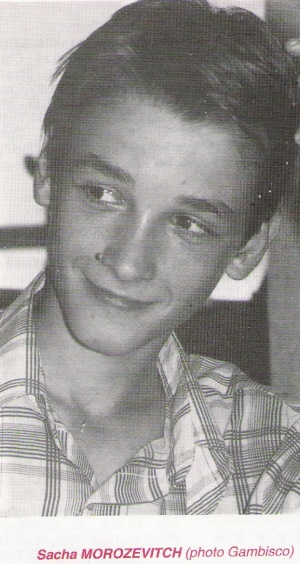


I`d like to start our conversation with a catchy position. May be this will be a good one.
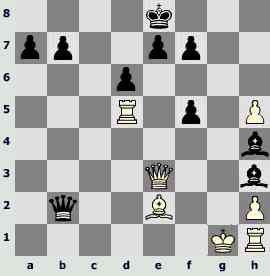
White to move
Take a few minutes to think how to escape a checkmate while I`ll tell you how this diagram appeared...
The winner of the championship of Moscow among adults in the summer of 1992 was 14-years old Sasha Morozevich. Soon after the tournament the young champion, the author of these lines and our friend Sergey Zhurov went to a holiday camp to Moscow suburbs where we supposed to rest and to sport. «Don`t pester the child with chess, walk more!» - Sasha`s coach Vladimir Nikolaevich Yurkov instructed us. Oh that!...
The camp was situated in a wood on the lake bank. We had luck as it was very warm and sunny. Beach, boats, ping-pong, billiards and other simple pleasures of life were at our full disposal. However the greatest part of the day we were spending in a small house, having bent our heads over a chessboard. It would be all right if we just analyzed openings, so to say suiting ourselves with novelties! We spent two or three days moving bishops and rooks across the board, analyzing my game from the same championship: Morozevich was very much interested, which king should be mated first. We were delving into the wilds of the Sicilian and at some moment we started to search the most paradoxical rather than the strongest moves. At that moment we didn`t have a computer that would bark: «Bosh!» therefore the variants which the youngest of us was carefully writing down in a copy-book, turned out to be absolutely fantastic. Larsen said: «All long variants are not correct». But this aphorism did not confuse Morozevich at all, and we continued competing in tactical foxery, even when we had been through with this game and went on to other positions. It`s hard to remember what else we were busy with at that distant get-together. It seems we analyzed Sasha`s games, looked through the Scotch game, Naidorf, a match Fischer - Spassky ...
Afterwards Alexander went to France and perfectly played two "Swiss games". The French were so much impressed by his bright manner of playing that they suggested the young candidate master to be a columnist in a magazine "Gambisco", which meant to send once a month comments to any two games. And in September 1992 issue appeared this publication.
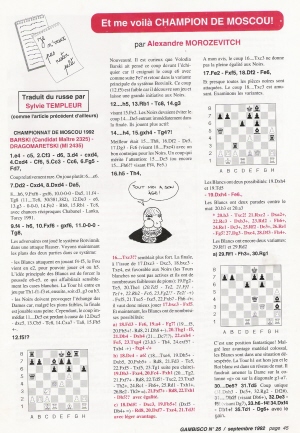
Alexander Morozevich (candidate master, 14 years old) comments
V.Barsky - E.Dragomarezky
Moscow 1992

V.Barsky, 1989.
Sicilian defense В61
1.e4 c5 2. ¤f3 d6 3.d4 cd 4. ¤:d4 ¤f6 5. ¤c3 ¤c6 6. Ґg5 Ґd7.
Rather a rare move. 6 ...е6 is played more often.
7. Јd2 ¤:d4 8. Ј:d4 Јa5.
8... h6 9. Ґ:f6 gf 10.0-0-0 Јa5 11.f4 ¦g8 (11... ¦c8) 12. Јe3 e6 13.g3 0-0-0 14. Ґe2 ўb8 15. ўb1 ¦c8 with mutual chances, Schabanel - Lanka, Torsi 1991.
9.f4 h6 10. Ґ:f6 gf 11.0-0-0 ¦g8.
Opponents have played Botvinnik system in Rauzer attack. Let`s analyze the plans of both players in this system:
- White attacks, playing f4-f5. The bishop comes on е2 to have an opportunity to go both on с4, and h5. The main idea of White is to force advancement е6-е5, which would essentially weaken white squares. The rook h1 enters the game by ¦h1-f1-f3 and then goes on d3, g3 or h3.
- Black should strive for the exchange of queens so that he won`t have problems in the ending despite a weak pawn. However the immediate move 11... Јc5 is losing because of 12. Ј:c5 dc 13. ¤b5 ¦c8 14. ¤:a7 ¦a8 15. Ґb5.
12.f5!?

A novelty. It is interesting, that Volodya Barsky has found this continuation over the board because he was afraid of е6 with the subsequent Ґe7 and getting back to the main variant of Botvinnik system. But the move 12.f5 is unsuccessful, as it closes the game and gives strong initiative to Black.
12... h5 13. ўb1 ¦c8 14.g3.
Planning 15. Ґe2. Ґlack should avoid 14... Јe5, immediately getting into the ending. He plays more actively.
14 ...h4 15.gh ¦g4?!
15... ¦h8 16. Јf2 Јc5 17. Јg3 Ґc6 would have been better (with the idea 18 ... Ґ:e4) with a good counter-play of Ґlack. 15... Јc5 or 15...Ґh6!? is also noteworthy , with idea Ґf4, Ґe5.
16.h5 ¦h4.
16... ¦:c3!? looks stronger.

The diagram of the analysis
Ending after 17.Ј:c3 Ј:c3 18.bc ¦:e4 is preferable for Black (White has passive rooks and many pawn weaknesses): 19. Ґg2 ¦e5 20. ¦he1 (20. ¦d5 ¦e2 21. Ґf1 ¦e1 + 22. ўb2 Ґc6 23. Ґg2!? ¦e2! °) 20... Ґ:f5 21. ¦:e5 fe 22. Ґ:b7 Ґh6µ.
17.bc Ґ:f5 is better.

The diagram of the analysis
Now White has many opportunities:
а) 18. Ґd3 Ґe6 19.a4 Ґg7! (19... f5 20. Ґb5 +! ўd8 21. Јh8 ќ) 20. ¦hg1 f5 21. Јb4 Ј:b4 + (21... Јc7!?) 22.cb Ґe5 23. ¦:g4 (23.h3 ¦h4 24.ef? ¦:b4 + °) 23... fgµ.
b) 18. Јc4 a6! (18... ¦:e4 19. Јb5 + Ј:b5 + 20. Ґ:b5 + ўd8 21. Ґd3 ¦e5 22. Ґ:f5 ¦:f5 23. ¦hg1 with unclear position) 19. Јb3 Ґ:e4 20. Ґc4 Ґ:h1 (20... ¦g2 21. Ґ:f7 + ўd8 22. ¦d5! ¦:c2 23. ¦:a5 ¦:h2 + 24. ўc1 Ґh6 + 25. ўd1 ¦:h1 + 26. ўe2 ¦h2 + =) 21. Ґ:f7 + ўd8 22. ¦:h1 Јb5!? With equality.
с) 18. Јd5! Ј:c3 19. Ґb5 +! (19. Ј:f5 Јb4 + =) 19... ўd8 20. Ј:f7 ¦:e4 21. ¦d3! with a slight advantage.
In my opinion, the move16...¦:c3 does not provide Black with absolute equality.
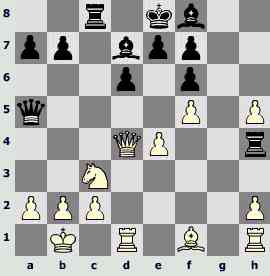
17. Ґe2 Ґ:f5 18. Јf2 Ґe6.
Almost all black pieces are attacked. The move18... ¦:c3 is interesting in this position.
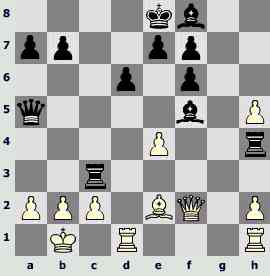
The diagram of the analysis
Let's have a look at the variants. White has two opportunities: I. 19. Ј:h4 and II. 19. ¦d5.
I. 19. Ј:h4 Ґe6.
White has two ways of protection against a checkmate: 1) 20.b3 and 2) 20.а3.
1) 20.b3.

The diagram of the analysis
20...¦:c2! 21. ў:c2 Ј:a2 + 22. ўc3 Ј:b3 + 23. ўd2 Ґh6 + 24. ўe1 Јc3 + 25. ўf2 Јe3 + 26. ўe1 Ґg5! 27. Јg3 Ј:e4 28. Јf3 Ґh4 +.
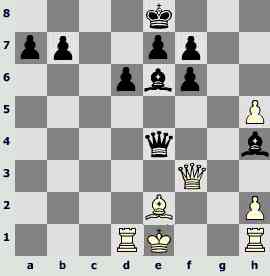
The diagram of the analysis
There are two possible variants for White: 29. ўf1 and 29. ўd2.
а) 29. ўf1 Ґh3 + 30. ўg1.
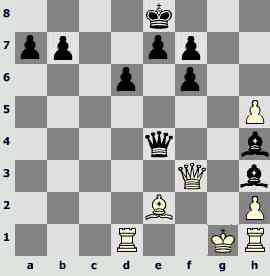
The diagram of the analysis
A fantastic position! Despite the enormous material advantage, the position White is hopeless. The rook h1 is out of game, and white king is in a mating net. Black needs to transfer the queen to file «g» or to the diagonal g1-a7.
30... Јe5! 31. ¦d5 (the only move; 31. Ј:h3 Јc5 + 32. ўg2 Јf2Х) 31... Јb2! (with the danger of Јb6 +) 32. Јe3 f5! (This is a position we began our article with - V.Ґ.) 33.h6 f4! 34. Ј:f4 Јb1 +! 35. ¦d1 Јg6 +, winning.
b) 29.ўd2 Јb4 + 30.ўc2 Јa4 + 31.ўd2 Јa5 + 32.ўe3 Јb6 + 33.ўd2 Јb2 + 34.ўe3 with unclear consequences.
I do not find any forced win, but I think that 20.b3 is a bad move. The queen and two bishops are chasing the white king all over the board. So after 20.b3 Black does not risk to lose.
2) 20.a3!

The diagram of the analysis
Black should force a drawn game: 20... ¦:a3 21.ba Ј:a3 22.c4 (22. ¦d5 Јb4 + with the danger of Ґ:d5 °) 22... Јb3 + with a perpetual check. It is possible to draw a conclusion, that continuation 19. Ј:h4 leads to a drawn game.
II. 19. ¦d5.
The only response is 19...Јb4 20. ¦:f5.
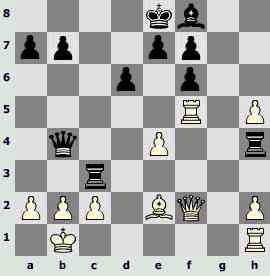
The diagram of the analysis
а) 20... Ј:e4 21. Ґf3 Јb4 (21... Ј:f5 22. Ґc6 + ќ) 22. Ј:a7 ¦:h2 [22... e6 23. Јb8 + ўe7 24. Ј:b7 + Ј:b7 25. Ґ:b7 ef (25... ¦c7 26. ¦b5 ќ; 25... ¦b4 26. ¦f3 ќ) 26.bc±] 23. Ј:b7 Ј:b7 24. Ґ:b7 ¦c:c2 25. ¦:h2 ¦:h2 26.a4±.
b) 20... ¦ch3 21. Ґb5 + ўd8 22. Ј:a7 ўc7 23. ¦d1 ¦:h2 24.a3 Ј:e4 25. ¦c5 + dc 26. ¦d7 + ўc8 27. Јa8Х.
c) 20... ¦hh3 21. Ј:a7 Ј:e4 22.bc! ¦:c3! (22... Ј:h1 + 23. ¦f1 Јd5 24. Јb8 + ўd7 25. Ґg4 + e6 26. Ґ:h3 ќ; 22... Ј:f5 23. Јb8 + ўd7 24. Ј:b7 + ўe6 25. Ґg4! ќ) 23. Јb8 + ўd7 24. Ґb5 + ўe6.
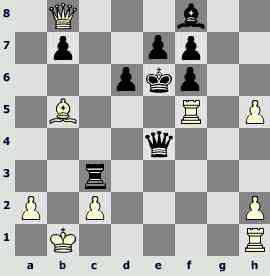
The diagram of the analysis
Another fantastic position. Despite an extra rook the position is very delicate. White tries to strengthen the position: 25. ¦hf1 ¦:c2 26. ¦1f4, and the attack is repelled.
From all the variants considered above it is possible to draw a conclusion, that an interesting move 18...¦:c3 leads Ґlack to deplorable consequences.
Let's return to the game.
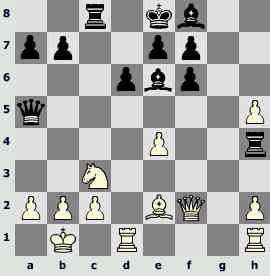
19. Ґb5 +!
White begins a forced winning combination.
19...ўd8 20. Ј:h4 ¦:c3 21. ¦:d6 + ўc8?
It is not necessary to accept a sacrifice of the rook: 21... ed 22. Ј:f6 + Ґe7 23. Јh8 +! (23. Ј:c3 Ј:b5 24.h6 Јa4 25.h7 Ј:a2 + 26. ўc1 Ґg5 + 27. ўd1 Ґg4 + 28. ўe1 Ґh4 + 29. ўd2 =) 23... Ґf8 24. Ј:f8 + ўc7 25. Јe7 + ўb6 26.a4ќ.
It`s better to play 21... ўc7 22. ¦:e6 Ј:b5 23.h6.
1) 23...¦f3 24.c4! Ј:c4 25. ¦c1 ¦f1 26. Јg3 +. Now Ґlack has many variants of retreat:
а) 26... ўc8.

The diagram of the analysis
27. ¦c6 +!! bc 28. Јh3 + ўc7 29. ¦:f1 Ґ:h6 30. Јf3ќ.
b) 26... ўd7 27. ¦d6 +! ўe8 (27... ed 28. Јh3 + ќ) 28. ¦dd1ќ.
c) 26... ўd8 27. Јb8 + ўd7 28. Ј:b7 + ў:e6 29. Јd5 + Ј:d5 30.ed + ў:d5 31. ¦:f1 Ґ:h6 32. ўc2ќ.
2) 23... fe 24.h7 Ґg7 25. Јg4 Ґh8 (25... Јb4 26. Ј:g7 ¦e3 27. Јg3 +!!) 26. Јg8.
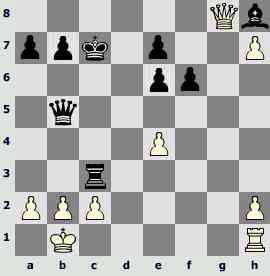
The diagram of the analysis
It is surprising, that this position has happened in the game and when it was a move of White, so Black has an extra tempo now. But the most surprising is that there is no danger of 27. Ј:h8 because after 27...¦:c2! 28. ў:c2 Јc4 + Ґlack gives a perpetual check. In spite of this fact Black loses the game:
a) 26... ¦f3 27. ¦d1 ¦f1 28. Јd8 + ўc6 29. Јd7 + ўc5 30. Ј:b5 +ќ.
b) 26... f5 27. Ј:h8 ¦:c2 28. ў:c2 Јc4 + 29. Јc3ќ.
c) 26... ¦:c2 27. Јg3 +! ўb6 28. ў:c2ќ.
d) 26... ¦c6! 27. ¦c1!! ќ (27. Ј:h8? ¦:c2 =; 27. ¦d1 ¦d6).
We have gone deep into details of the position and we can notice that not everything is painted in glowing colours for Black. May be he has made a mistake at some point? In my opinion, the plan with 15.... ¦g4 was not correct as it`s antipositional, though active. 15...Јc5 or 15...¦h8 are stronger.
Let's return to the game.
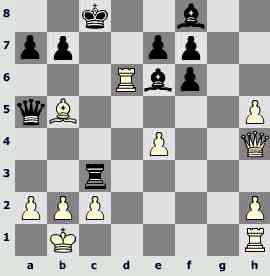
22. ¦:e6!
The main attacking piece is crushed.
22...Ј:b5 23.h6 fe 24.h7 Ґg7 25. Јg4 Ґh8 26. Јg8 + ўc7.
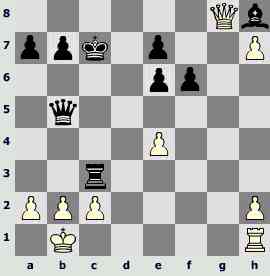
27. ¦d1 ¦h3 28. Јd8 + ўc6 29. Јc8 +.
Black resigned.
It is necessary to note a good playing of White, but Dragomarezky has shown a kind of foppery.
* * *
Those old notes are left without changes, only diagrams are added for visualization (the Internet affords such a luxury, but sometimes there is not enough place in magazines or newspapers). It was also necessary to retranslate it from French as it would have taken a lot of time to look for the original comments of Morozevich in Russian, if they`ve survived. And the magazine (which, alas, has not been published for about 10 years) I have recently found on the distant top shelf and decided to check our old analyses with the help such a habitual friend Fritz. It is pleasant to note, that old bean did not criticize us severely, and here and sometimes discreetly commended. But of course there were things he noted. Those who wish, can view variants on the computer, I shall mention only the most essential remarks.
I. 16... ¦:c3!? (instead of the move 16...¦h4 that was made in the game) 17.bc Ґ:f5.

The diagram of the analysis
In variant а) 18. Ґd3 Ґe6 19.a4 Ґg7 20. ¦hg1 f5 21. Јb4 Ј:b4 + 22.cb; 22... Ґe5 is hardly a good move because of 23. ¦:g4 fg 24. ¦d2. 22...fe 23.h3 ¦h4 24. ¦:g7 ed 25. ¦:d3 are stronger. In any case, the estimation «µ» should be changed for «„.
In variant b) 18. Јc4 a6 except 19. Јb3 is noteworthy 19. ¦d4 Ґe6 20. Јa4 + Ј:a4 21. ¦:a4І.
And in variant с), as they say, «there was a misprint»: after 18. Јd5 Ј:c3 19. Ґb5 + ўd8 20. Ј:f7 ¦:e4 loses 21. ¦d3? Because of 21...¦b4 + 22. Јb3 Ґ:d3. 21.a3? Ј:a3 22. Ґc4 Јb4 + 23. Ґb3 ¦e2 are also bad, but 21. Ј:f8 + 21... ўc7 22. ¦d3 ¦b4 + 23. ўc1 Јe5! help to maintain the balance.
In spite of the re-estimation of each variant, the general conclusionof Morozevich «in my opinion, the move 16...¦:c3 does not provide Black with absolute equality» seems to be correct. It is impossible to analyze everything, but the intuition usually does not let down strong chess players.
II. 18...¦:c3 (instead of a the move 18...Ґe6 made in the game) 19. ¦d5 Јb4 20. ¦:f5.
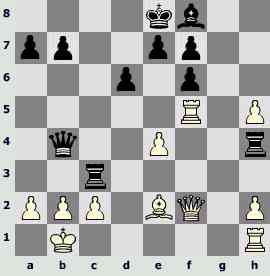
The diagram of the analysis
In variant b) 20... ¦ch3 21. Ґb5 + ўd8 22. Ј:a7 ўc7 the move 23. ¦d1 is inaccurate because of 23...¦:h5 ›, and 23.a3! Ј:e4 24.¦c5 + dc 25.¦d1 Јd4 26. ¦:d4 cd 27.Ґa6ќ are winning.
c) 20... ¦hh3 21. Ј:a7 Ј:e4 22.bc ¦:c3 23. Јb8 + ўd7 24. Ґb5 + ўe6.

The diagram of the analysis
«White tries to strengthen the position: 25.¦hf1 ¦:c2 26.¦1f4, and attack is repelled» (A.Morozevich).
Actually, after 25.¦hf1? Ј:c2 + 26. ўa1 Јd2 Black is rescued. 25. Ґd3! 25... Ј:h1 + 26. ¦f1ќ are correct.
Generally, all these are only specifications which do not influence the estimation - «From all the variants considered above it is possible to draw a conclusion, that an interesting move 18...¦:c3 leads Black to deplorable consequences».
III. The analysis of the continuation 21...ўc7 (instead of the move 21...ўc8 made in the game) 22. ¦:e6 Ј:b5 23.h6 is very beautiful. But White has a shorter and more efficient way to the goal- 23. Јf4 + ўc8 24. ¦e5!
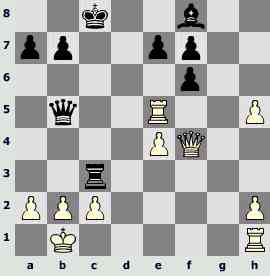
The diagram of the analysis
The rook walks about the beaten squares feeling itself at home! Nevertheless, no rescue can be seen for Ґlack, for example: 24...fe 25. Ј:f7 Ґh6 [25... ¦:c2 26. Ј:f8 + ўc7 27. Ј:e7 + ўc8 28. Јe6 + ўc7 29. ў:c2 Јe2 + 30. ўb3 Јf3 + 31. ўb4 Ј:h1 (31... Ј:e4 + 32. Јc4 +) 32. Ј:e5 + ќ] 26. ¦d1 ўb8 27. Ј:e7 ¦c8 28. Јd6 + ўa8 29. Ј:h6ќ.
IV. And now it is time to return to the position our article began with. As we know, it appeared from the variant 18...¦:c3 (instead of the move 18...Ґe6 made in the game) 19. Ј:h4 Ґe6 20.b3 ¦:c2 21. ў:c2 Ј:a2 + 22. ўc3 Ј:b3 + 23. ўd2 Ґh6 + 24. ўe1 Јc3 + 25. ўf2 Јe3 + 26. ўe1 Ґg5 27. Јg3 Ј:e4 28. Јf3 Ґh4 + 29. ўf1 Ґh3 + 30. ўg1 Јe5 31. ¦d5 Јb2 32. Јe3 (32. Јd3 a6 › - V.B.) 32... f5.

The diagram of the analysis
Here again the computer has found a variant for which I want to thank it very much: 33. ¦:d6!! Јg7 + 34. Јg3!! (34. ¦g6? Јa1 +) 34...Ґ:g3 (34... Јa1 + 35. ¦d1 Ј:d1 + 36. Ґ:d1 Ґ:g3 37.hg ќ) 35. Ґb5 + ўf8 36. ¦d8#.
To tell the truth, from all this beauty follows only, that on the 26-th move Black should play more modestly - 26... Јc3 + and to force a drawn game by a perpetual check.
I have no doubt, that there are many not less beautiful variants that remained off-screen, but this is not the main thing. I just wanted to show to the readers, first of all to the young, that games analysis is a fascinating creative process from which you can get a great benefit. So remember the words of Botvinnik and send us your comments. We promise that the best of them will be published!
Vladimir Barsky,
International master
